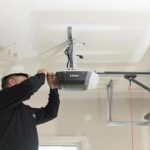What is the most common spring for garage doors?

Broken garage door springs are perhaps the most common garage door repair. If a spring breaks, your motor won’t work properly and your door won’t open as it should. So, what is the most common spring for garage doors? Which one is the best option for you if you’re a DIY expert or simply want to know which one is best for your home? Read on as we’ll describe the types of springs and when they should be used. Our hope is that you’ll be well-informed and make good decisions!
Extension Springs
Extension springs attach to pulleys along a garage door to help control the raising and lowering of the heavy door. As the name implies, these springs work by expanding and contracting. A prime example of an extension spring is the springs found inside battery-operated toys.
There are three primary varieties of extension springs, each called after the design of the portion that attaches to the pulley. Below, we’ll look at how each kind varies.
- Open-loop end extension springs: It consist of one layer of spring bent outward to form the loop. These are the least durable varieties since the loop is not shielded against deformation while in operation.
- Double-loop end extension springs: It consist of two layers of spring bent outward to form a loop. These springs have mediocre longevity since the loop can pull and loosen the spring at its edges.
- Clipped-end extension springs: Cut-end extension springs are wrapped in a separate piece of metal that resembles a loop. Because the metal is separate from the spring, these are the most durable extension springs.
Torsion Springs
Torsion springs are coupled to the garage door wires toward the top of the door. They employ rotational tension to control your door. To illustrate how they appear, consider the torsion spring that goes inside your clothespins.
There are a few signs that your garage door has torsion springs. First, determine if they are positioned over the garage door. They might end in metal cones or connect to a metal tube. To make things easier, many garage door spring manufacturers color code their torsion springs to indicate whether their tension is left or right. Below are the types of torsion springs:
- Standard Torsion Springs: these are the most fundamental form of torsion spring. The wire is drawn straight from each end of the spring. These straight parts are where the mechanisms exert effort to generate or relieve tension when the door opens and closes.
- Steel Rolling Door Torsion Springs: These springs are designed to operate with steel rolling garage doors. These doors function differently than other types of garage doors, necessitating a unique type of spring.
- Easy-Adjust Torsion Springs: The easy-adjust torsion spring functions similarly to the normal torsion spring. However, it is positioned at the center of the torsion shaft.
So which one would you choose? Torsion springs or extension springs?
Your garage door would be better off with coated torsion springs. We explain why: Torsion springs are safer than extension springs and typically last twice as long. A torsion spring’s coating extends its life beyond that of a standard torsion spring.
Torsion springs are safer than extension springs since they are self-contained. When they shatter, they do not become ballistic missiles. However, extension springs are capable of doing so. Building rules require extension springs to have safety wires installed so that if they break, they do not launch parts.
Final Thoughts:
Now that you know most common spring for garage doors, you can make informed decisions for your home. If you do not want to do the repairs yourself, contact us, Seamless Systems will be happy to help! Our experts are known for delivering quality work without delay. Call today at (307) 680-6103 for a free quote!




